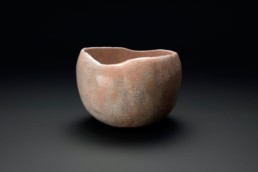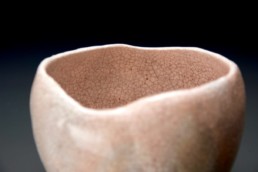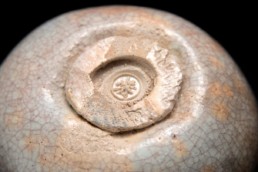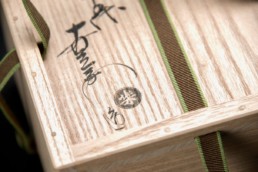Raku XV “Reki-yu” Tea Bowl
Artist:Raku XV (Jikinyu)Era:ContemporaryPrice:Inquire for priceInquire:info@shirakuragallery.com
Raku tea bowls and other tea-ware implements are shaped by hand, using clay that was prepared often several generations before by a previous Kichizaemon (master potter in the Raku tradition). The kilns are all wood-fired and the glazes and methods used are family secrets, handed down over generations, for the last 450 years.
Born in 1941 and taking over as master potter in 1983, the 15th Kichizaemon recently stepped down to make way for his son Atsundo who became the new torchbearer of the Raku line. Following the tradition of Raku potters, after retiring he took on an artists name and is now known as “Jikinyu” while his son Atsundo is now known as Raku Kichizaemon XVI. The tea bowl featured here was crafted at the very end of the 20th century; and, though based on designs of the great masters nearly half-a-millennia ago, clearly demonstrates the nature of XV’s unique, yet subtle genius.
Unlike previous Raku potters, XV took great liberties with form and proved far more innovative in his approach to crafting tea-ware ceramics. So much so in fact, that many of his more experimental pieces are not well-suited for drinking tea out of. The piece featured here however, is ideal for preparing and drinking matcha green tea. The smooth contours and silky glaze allow the cha-sen (bamboo tea whisk) to move freely, unobstructed; the construction, meanwhile, allows the the tea to cool to the perfect temperature; and the form allows the bowl to sit naturally in the hand.
Tea bowls made by the current Kichizaemon are typically only available to museums, public and private institutions, members of the imperial household, and very well-connected and wealthy practitioners of tea. Now that Jikinyu has retired, his pieces are more available but still hard to come by, especially iconic pieces like the one shown here. A similar example is held by the Raku Museum in Kyoto (link below) and is listed in Raku: A legacy of Japanese Tea Ceramics, p 305 (also in several other publications). The wood box is signed and sealed by XV and is also endorsed by a famous tea master of the Urasenke tea school, Hōunsai.
Additional Resrouces:
https://raku-yaki.or.jp/e/museum/collection/collection_16.html
https://www.jpf.go.jp/e/project/culture/exhibit/oversea/2014/03-01.html



